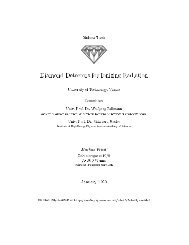Create successful ePaper yourself
Turn your PDF publications into a flip-book with our unique Google optimized e-Paper software.
the operating conditions at the LHC. As a consequence of these efforts, the initial drawback of lowlight yield has been overcome by progress in crystal growth and through the development of largeareasilicon avalanche photodiodes. In Table 1.1 the properties of PbWO 4 are compared with thoseof other crystals used in electromagnetic calorimeters.Table 1.1: Comparison of properties of various crystalsNaI(Tl) BGO CSI BaF 2 CeF 3 PbWO 4Density [g/cm 3 ] 3.67 7.13 4.51 4.88 6.16 8.28Radiation length [cm] 2.59 1.12 1.85 2.06 1.68 0.89Interaction length [cm] 41.4 21.8 37.0 29.9 26.2 22.4Molière radius [cm] 4.80 2.33 3.50 3.39 2.63 2.19Light decay time [ns] 230 6030016 0.96308255 (39%)15 (60%)100 (1%)Refractive index 1.85 2.15 1.80 1.49 1.62 2.30Maximum of emission [nm] 410 480 315 210310300340440Temperature coefficient [%/°C] ~0 –1.6 –0.6 –2/0 0.14 –2Relative light output 100 18 20 20/4 8 1.3Table 3.1: Comparison of scintillator materials used in high-energy physics [17].1.3.1 Developments since the Technical ProposalSince the submission of the CMS Technical Proposal in December 1994 [1.4] substantialto progress otherhas candidate been made materials on the following (see Table aspects 3.1) of inthe allelectromagnetic these respectscalorimeter except forproject:a comparatively–lowcrystallightparametersyield.suchHowever,as scintillationthis disadvantagespeed (decaycantimebeconstant),compensatedmechanicalbytolerancemodernphotodetectors. and light yield Further have complications been significantly areimproved;introduced by the temperature dependenceof the light output, which requires cooling to maintain the standard operating temperature–ofit18has ◦ Cbeenthroughoutshown thattheirradiationinstrumentdoes notandaffectthetheradiationscintillationenvironment.mechanismTheand thatdirecttheintrinsic energy resolution is not degraded. Nevertheless, radiation damage affects theeffect of radiation on the crystals leads to the formation of color centers, which reducecrystal transparency through the formation of colour centres, causing a loss in the amountthe transparency of light collected. of theIt crystal. has been However, shown that since the calorimeter PbWO 4 isperformance optically transparent, can be maintained thistype of by degradation following the canlight be measured loss using a through laser-based controlled monitoring illumination system. Extensive with laser studies light onduring operation radiation damage and compensated have led to a for better in understanding reconstruction. of its underlying causes and to theproduction of acceptably radiation-hard crystals in a reproducible way;– avalanche photodiodes (APD) are used to collect the scintillation light in the barrel regionsince they are able to provide gain in the presence of the high transverse magnetic field.GeometryTheir performance has been improved in a successful collaboration with two industrialfirms. This R&D programme has achieved a better quantum efficiency, a reducedThe ECAL’s sensitivity geometry to the passage is illustrated of charged in particles, Fig. 3.6. and The a higher barrelradiation part oftolerance.the ECAL (EB)covers the range of 0 < |η| < 1.479. The granularity is 360-fold in φ and (2×85)-fold inIn the endcaps the photodetectors are required to survive a much higher integratedη. Eachradiation crystal has dose a tapered (50 kGy) pyramid and neutron shape, fluence measuring (7 × 10about 14 n/cm 2 22×22 ). At these mm 2 fluences (matching thethe Moliére induced radius) leakage on the current inner for face APDs and would 26 × lead 26 mm to an 2 on unacceptable the outer energy face, with equivalent a length ofof 230 mm or 25.8 X 0 , chosen to limit longitudinal shower leakage to acceptable levels.The placement of the crystals is almost projective with regard to the interaction point,but slightly offset in both η and φ to avoid leaving cracks along likely particle paths.4The endcaps extend the range to 1.479 < |η| < 3. Crystals on the endcaps have afront face area of 28.62 × 28.62 mm 2 , a rear face area of 30 × 30 mm 2 and a length of220 mm or 24.7 X 0 . Again, hermeticity is improved by focusing the front faces of thecrystals on a point about 1 m behind the nominal interaction point.24












